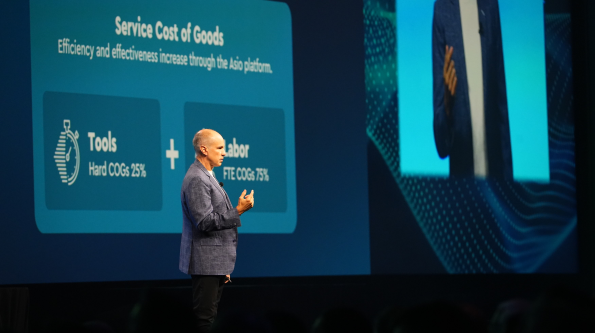While IT asset discovery and IT asset management are core functions of the MSP-client relationship, these can be tedious tasks, and technicians would rather spend their time solving high-priority IT problems and risks. IT asset management best practices exist to assist your organization in eliminating duplicate assets, reducing overall costs, and to ensure compliance with local and international laws and regulations.
We’ll explore some of the best ways that MSPs can make IT asset discovery and management more efficient, which will result in happier technicians, generate better productivity, and boost client satisfaction. In this blog, we’ve compiled a list of both IT asset discovery best practices and best practices in asset management.
How IT asset discovery and asset management help MSPs
IT asset discovery and asset management work hand in hand to provide various benefits for MSPs including assisting them with tracking physical and virtual inventory, map asset availability, and improving efficiency by providing real-time insights into asset usage and overall asset visibility.
IT asset discovery and asset management: what's the difference?
IT asset discovery is the process of using automation to identify, organize, and monitor IT assets such as IT equipment and software. Asset management is the entire process of managing and tracking any IT assets within the company or that it maintains control of. Asset management best practices focus on assisting your organization with:
- Maintaining a proper inventory of IT equipment and components
- Provide guidance on when to upgrade obsolete devices
- Track resource allocation and costs more efficiently
While asset management has many functions within an organization, there are several ways assets are managed:
- Manually
- DAM (Digital Asset Management)
- Custom asset management software or tools
IT asset discovery: the foundation of IT asset management
As we all know, IT asset discovery is a foundational part of any MSP’s engagement with clients.
IT asset discovery is the act of understanding the full scope of all the devices on a client’s network, such as laptops, mobile devices, printers, servers, and more. When assets linger on a network without being accounted for, it introduces operational and security risk. An unmanaged or unpatched computer, for example, could:
- Lead to gaps in patch management
- Give hackers the toehold they need to infiltrate the network
- Allow malware such as ransomware to self-install
- Lead to compliance issues and undiscovered data leaks
MSPs can implement the following IT asset management best practices to reduce the burden on technicians while ensuring no device goes undiscovered or unmanaged for long.
1. Put network scans on autopilot
As mentioned above, an organization’s IT assets are constantly growing. Consider that a business founded 30 years ago may have only needed to contend with desktop computers in a single office environment with one corporate network. Simple setup, right?
Fast forward to today, and that same company is likely managing many dozens (if not hundreds) of assets, from laptops to mobile phones, tablets to wireless printers, physical to cloud servers and more. And forget the traditional IT network. Employees are working remotely from many different locations on public Wi-Fi or home networks.
Complex IT environments like this make it easy for devices to join or leave networks undetected. That’s why automated IT asset discovery scanning is crucial.
With regular network scans via a remote monitoring and management (RMM) solution, MSPs can quickly find new assets—and understand whether they should be on the network to begin with. If they are, MSPs can then effectively track and manage those assets.
Automated scanning also allows technicians to breathe a sigh of relief. They can focus on urgent client requests, while their RMM chugs away quietly in the background.
2. Automate your agents
Ultimately, MSPs need to make IT asset discovery and IT asset management scalable. That means they need an easy, repeatable process to find, account for, and reconcile all the devices that they should be monitoring for clients.
Automation can help with this, too. By automating the deployment of agents, MSPs can systematically ensure the discovery and tracking of devices. When agents are automatically installed on new devices, it means that technicians don’t need to spend time configuring what is likely a pretty standard setup. It also means that there’s not a large gap between an asset entering the network and the technician’s ability to address potential risks or problems.
Automating agents also allows MSPs to customize settings (such as which devices are automatically recognized on the network) and simultaneously sync data within their RMM solution. With greater discovery and monitoring capabilities and more data on each device, MSPs can more effectively manage accounts and provide better service to customers.
Take ConnectWise Automate, which allows organizations to deploy agents to endpoints quickly with our Network Probe Technology. This can offer a good option beyond Active Directory Group Policies, especially in environments with multiple workers or groups.
For example, with ongoing deployment of agents to all new devices, MSPs can:
- Manage by exception if/when an unknown device enters the network and remove the device quickly
- Stay aware of every device that needs to be managed—even those that clients purchase outside the contract without telling the MSP
- Get ahead of clients’ issues
- Prevent network threats by monitoring and managing every device
With agents on every asset, MSPs can more easily maintain and manage routine tasks. In fact, many of these routine tasks, such as patching, can be automated, too. By reducing the amount of technician time spent on these actions, MSPs can realize significant time and financial savings.
For example, our Total Economic Cost of the ConnectWise Platform report found that MSPs saved 60 percent of time by automating away some routine hardware maintenance tasks. With less technician time spent on these tasks, organizations reduced the expense of maintaining hardware by $1.2 million over three years.
3. Create a centralized database and dashboard
Assets add up fast. MSPs can make it easier to see the big picture by creating a centralized place to understand and manage every asset on a client’s network. With a dashboard view of everything, MSPs can quickly view which assets need which services.
For example, MSPs can understand at a glance when assets:
- Are having ongoing performance issues
- Could pose a security threat
- Are being used in out-of-policy ways
No matter what your clients need, a single source of the truth will help your MSP business deliver better service and maintain better security. Take, for example, ConnectWise customer Keller Logistics. With ConnectWise Automate, they were able to combine multiple IT management functions into a single platform, giving them a “God view” of IT. In the words of their IT Security Analyst:
“We utilize the tree in ConnectWise Automate to show us reports of what software is out of date on certain PCs. We can check a user’s software version, whether it’s Java, PDF Reader or a proprietary application. We don’t need to remote into computers to check versions. That saves labor because our technician can instantly see that he doesn’t need to touch three-quarters of the PCs in order to update a particular software version, for example.”
4. Communicate with clients via your PSA
Great IT asset discovery and IT asset management can help MSPs boost sales opportunities. When MSPs have full view and control of assets, they can help clients understand when devices need to be upgraded, replaced, and more.
IT asset discovery and management can yield valuable information, such as:
- Hardware that will soon expire and needs to be replaced
- Demand for new software licenses (and renewals)
- Necessary repairs and upgrades
- Device-specific information, such as barcodes and tickets
With IT asset discovery and management feeding information into the PSA, MSPs can more easily bring in revenue. How? Better communication.
The data points mentioned above can be integrated into a professional services automation (PSA) tool, which the sales team can use to expand or renew contracts. A good PSA solution can automate notifications, making the sales team’s job easier and ensuring efficient and timely communication with clients.
Integrating this data into a PSA also benefits technicians. After all, old, outdated, and poor-quality technology takes way more work to maintain. When clients replace technology with modern, high-quality tech, their IT works better and MSPs face less of an uphill battle on service delivery costs—a win/win for everyone. It also frees up time to focus on other business-critical tasks, such as expanding into fast-growing revenue opportunities, such as the demand for cybersecurity services.
5. Integrate inventory and IT asset management with your stack
With managing a fleet of assets comes ordering: replacement devices, upgrade kits, software licenses, and more. With so much more IT complexity, it’s not hard for IT inventory and asset management to get out of hand, which can lead to issues such as:
- Problems with procurement and purchasing
- Messy billing cycles with dropped or missed items
- Challenges in accurately maintaining asset health
- Frustration from technicians and clients alike
In order to accurately manage devices and get paid for each item ordered, MSPs need a good way to track every single asset and tie each one to services received, replacement costs, and more.
MSPs can do this by integrating procurement into their RMM and tech stack. When this happens, MSPs can accurately manage assets from the day their barcodes scan into the system to the day they’re retired and replaced.
With a good RMM and integrated IT inventory and asset management function, MSPs can:
- Group multiple products and orders into a single shipment
- Enter custom handling instructions for sensitive or fragile orders
- Automatically renew orders or billing
- Track every PO, serial number, and barcode
- Keep a close eye on low-stock items
- Manage warehouse stock
6. Conduct continual asset management to reduce risks
When they go unknown, unpatched, and unprotected, IT assets represent a cybersecurity risk. Bad actors can find their way into networks via long-forgotten tablets, improperly configured or monitored internet of things (IoT) devices, and more.
In short: It’s impossible to implement good endpoint protection if you don’t know what all the endpoints are.
And many MSP clients know their endpoint protection is lacking. In fact, our 2022 State of SMB Cybersecurity Report found that 59 percent of companies don’t have advanced endpoint protection in place, while 56 percent don’t have advanced network protection in place. That’s a lot of opportunity for a hacker to slip through the defenses.
MSPs can help their clients by implementing better IT asset management processes and by finding the right tools to protect networks and devices. Routinely assessing assets can play an important role in catching issues—such as outdated patches or unlicensed software—that pose security threats. After all, MSPs don’t want to ignore activity that could pose a danger. Be sure to continually evaluate asset management practices, processes, and solutions.
Implement ITAM today
IT asset discovery and management is a routine, foundational function at any MSP—and that’s why it’s so important. Without good IT asset management processes and tools, MSPs lose visibility and control. After all, you can only manage what you know actually exists. Contact us today or watch our on-demand demo to learn more about our RMM and IT automation solutions.













